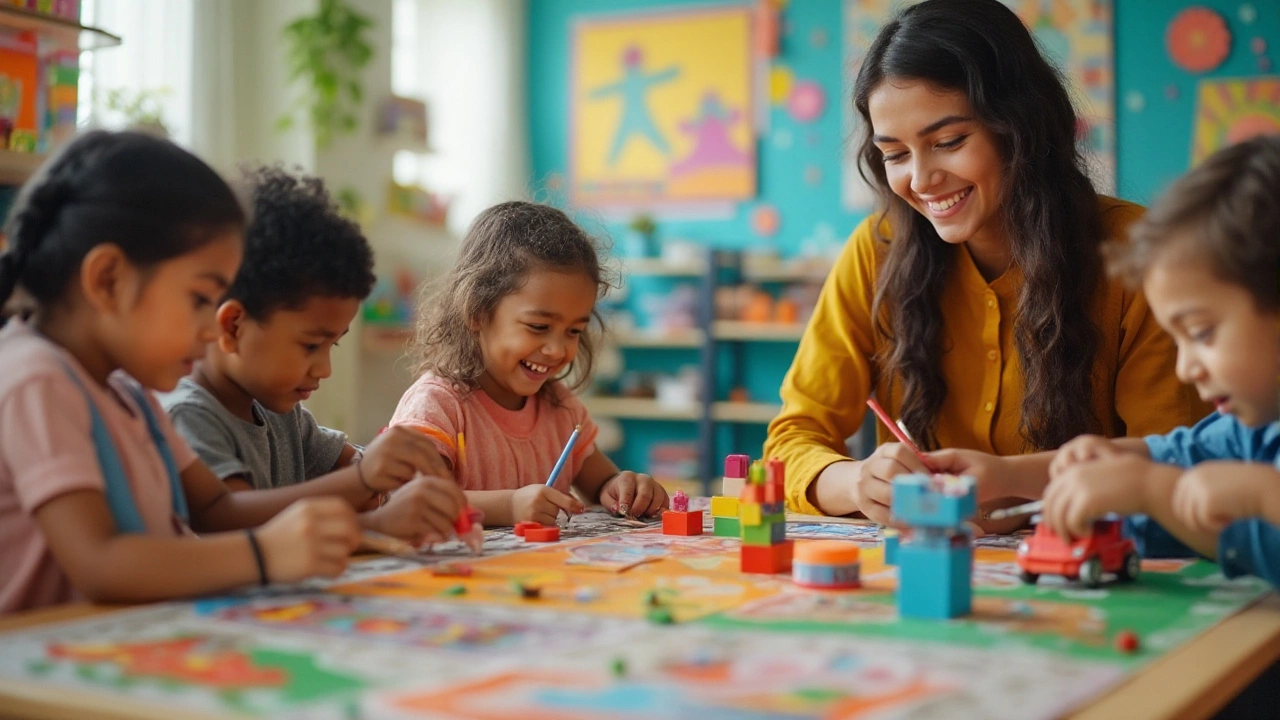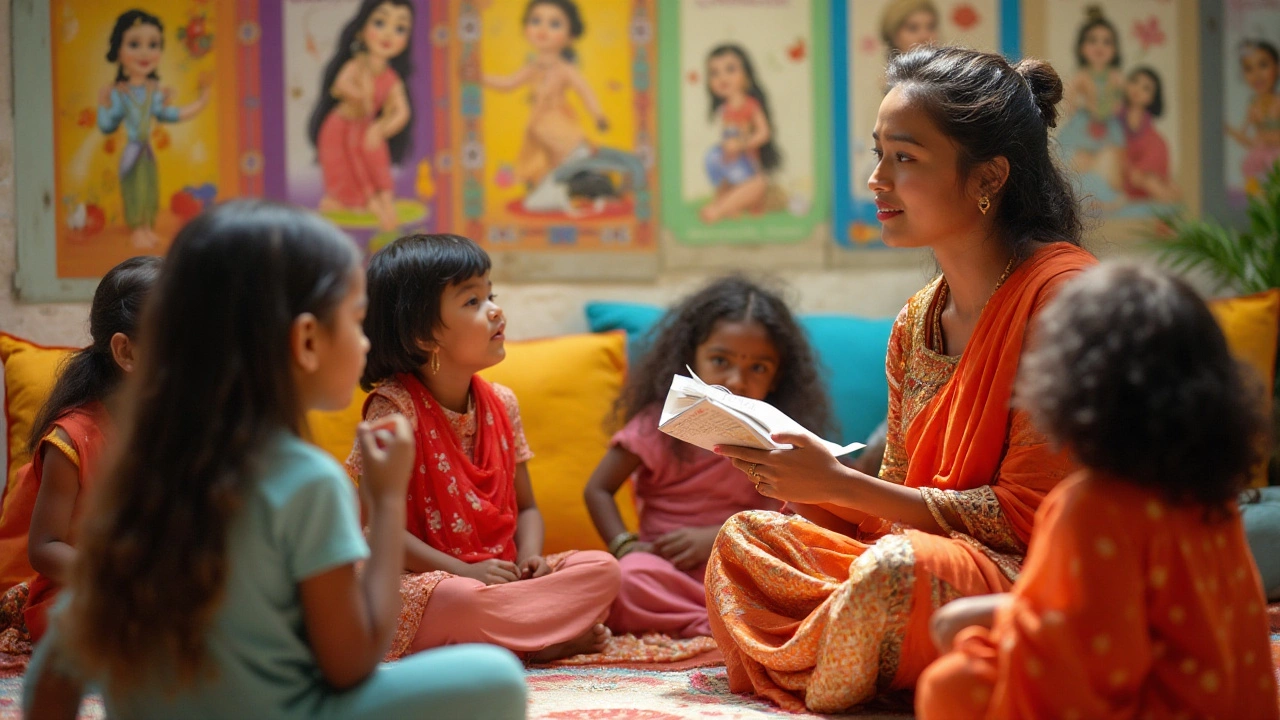Key Elements of Successful Kids Clubs: Engaging Afterschool Activities
 Jan, 24 2025
Jan, 24 2025
Choosing the right after-school club for your child can be a daunting task. As parents, we want to ensure that the time they spend outside the classroom is not only productive but also enjoyable. The right kids club can provide a blend of learning and fun, creating an environment where children can explore new interests, make friends, and develop skills that they'll use throughout their lives.
A great kids club balances structured activities with free time, encouraging creativity while promoting social skills. It should be a space where children feel comfortable and secure, guided by adults who are both nurturing and knowledgeable. From arts and crafts to sports and STEM projects, the possibilities are endless when it comes to engaging young minds and bodies.
- The Importance of a Welcoming Environment
- Diverse and Engaging Activities
- Role of Qualified Educators
- The Impact of Safety Standards
- Choosing the Right Club for Your Child
The Importance of a Welcoming Environment
Imagine walking into a place that feels just like home, a sanctuary where every corner echoes warmth and acceptance. For children, a kids club should embody this sense of comfort. This welcoming environment is more than just bright colors and fun decorations; it's about creating an atmosphere of inclusivity where every child feels safe and valued. In such spaces, children have the confidence to explore, take risks, and ultimately thrive. They need to know that they are accepted for who they are, without judgment or comparison, which fosters an environment ripe for personal growth and development.
One of the pivotal aspects of a welcoming environment in after-school clubs is the establishment of a routine that balances flexibility and structure. Children appreciate predictability, as it provides them with a sense of security. When kids know what's coming next, they can better manage their expectations and feel more at ease trying new things. Yet, the magic happens when enough flexibility is allowed so that creativity flows and spontaneity is welcomed. Teachers and facilitators who make a conscious effort to greet each child warmly and engage them in varied activities set a positive tone for the rest of the day's adventures.
An environment that celebrates diversity can also enhance the success of any kids club. Whether it’s through stories that reflect different cultures or activities that expose kiddos to new ideas, diversity enriches the club experience. Similarly, incorporating child-friendly language and concepts about different ways of life can broaden young minds and encourage empathy and understanding. A study featured in the Journal of Child Development revealed that children who engage regularly in culturally diverse environments display heightened emotional intelligence and active empathy compared to peers in more homogenous settings. By celebrating diversity, clubs are not only creating a place where children feel they belong but are also preparing them to become considerate global citizens.
"Inclusion is not merely about physical proximity. It is about intentionally planning for the success of all students." –Sina L. Singh
Having well-trained staff members is paramount to maintaining a safe and nurturing environment. Encourage ongoing professional development that focuses on child development and positive discipline techniques. These educators not only need to manage groups of children but also must actively listen and support each child, understanding their unique needs and what makes them tick. Personalized attention goes a long way in making every child feel acknowledged, and it contributes to building their self-esteem.
Finally, a welcoming environment thrives on strong communication channels between parents, children, and staff. Parents should feel confident about the care and attention their children receive. Regular reports, updates, and parent meetings establish transparency and build trust. Open communication invites parents into the community, encouraging them to share insights about their children that could benefit club organizers. Trusting the relationship between those responsible for the child's well-being ensures continued growth and ensures that every participant has the best experience possible.
Diverse and Engaging Activities
When considering what makes a kids club truly stand out, the variety and engagement level of activities cannot be overstated. A broad spectrum of options is crucial as it addresses the different interests and aptitudes of children attending after-school programs. It is important for kids clubs to offer a suite of activities that reflect a balance between academic reinforcement and creative exploration. When children step into an after-school environment, they should feel a sense of excitement and curiosity, both of which are fostered when they are given the chance to try new things and explore diverse interests.
Research by the Afterschool Alliance highlights that children who participate in programs with a diverse range of activities show improved school attendance and higher academic performance over time. Activities can vary widely from arts and crafts to technology clubs like coding or robotics, each designed to stimulate different parts of a child's mind. For example, a simple art activity can improve fine motor skills and encourage self-expression. Meanwhile, a session in a tech club might unlock logical thinking and problem-solving abilities. These opportunities also stimulate teamwork, as many activities require children to work in groups or pairs, developing essential collaboration skills along the way.
Unleashing Creativity Through Variety
Creativity is often considered an essential life skill, and what better way to nurture it than through a variety of hands-on activities? Experiences that enable children to engage in drama, music, or dance can open up new worlds of imagination and self-expression. The Performing Arts Education Association notes that children involved in such programs are more likely to be creative thinkers later in life. Creative activities help students understand the importance of persistence and resilience, especially when they face challenges that require innovative solutions. When a child learns to play a song on the piano or memorizes lines for a play, they are not only learning the art itself but also discipline and focus, which are crucial skills in both academic and personal settings.
"Participation in the arts leads to improved academic outcomes," states a report from the Arts Education Partnership, "and fosters social engagement that is indicative of success post-education."Furthermore, the social aspect is not to be overlooked—shared artistic endeavors are excellent at building friendships and strengthening community bonds, which are crucial for personal development.
Combining Play with Learning
Kinetic activities such as sports and games are equally essential as part of after-school programs. While these activities seem to be all about play, they significantly contribute to a child's physical development and team-building skills. Sports form an integral part of diverse after-school offerings, helping children improve their physical health and understand the need for a healthy lifestyle. Such activities also teach leadership skills and perseverance in a fun setting. According to research by the Aspen Institute's Project Play, children involved in physical activities are also more confident and perform better academically. Consider programs that integrate technology, such as interactive learning games or coding workshops, which blend play with education seamlessly. These programs illustrate concepts practically, making learning tangible and enjoyable. The key lies in keeping the learning process engaging, ensuring that kids look forward to attending these clubs every day.

Role of Qualified Educators
In the vibrant tapestry of kids clubs, educators play an indispensable role that transcends mere supervision. They're the architects of a child's after-school world, crafting experiences that inspire and engage. The magic of a well-run club often lies in the hands of these dedicated individuals who bring both passion and expertise to the table. Children are observant, and the energy they receive from educators can significantly influence their enthusiasm for club activities. In fact, studies show that children who participate in programs led by skilled educators demonstrate better social skills and increased self-confidence.
Educators in these environments are not just instructors but mentors and guides who ignite curiosity and encourage exploration. They possess the ability to turn a simple activity into a learning opportunity by asking probing questions and planting seeds of wonder that children eagerly chase. This demands a blend of creative thinking and an understanding of child development, something that set apart exceptional clubs from ordinary ones. Educators must be well-versed in various fields, ranging from the arts to technology, to cater to the diverse interests of children. A background in early childhood education can be a huge advantage as it equips them with strategies to address the varying emotional and cognitive needs of young learners.
The impact of qualified educators extends to the implementation of effective communication strategies. They actively listen and foster an environment where children feel valued and heard. This approach promotes positive interactions and resolves conflicts amicably, as children learn to express themselves and understand others. Shirley Dean, an educator with over 20 years of experience, once mentioned,
"The key to a successful after-school club is not just in the activities offered but in how well the educators connect with the children. It's about building trust and nurturing a love for learning."
It's also essential for educators to continually update their skills. This is especially true in today's fast-paced, technology-driven world where new teaching tools and methodologies emerge regularly. Professional development programs provide educators with fresh approaches to engaging children, ensuring that clubs remain dynamic and relevant. Workshops and training sessions can introduce educators to the latest practices in inclusive education, encouraging them to create environments where every child can thrive, regardless of ability or background.
Additionally, the role of educators encompasses assessment and feedback, where educators observe and document children's progress to tailor activities that best support their growth. These insights are invaluable, enabling educators to design a curriculum that is both challenging and attainable. By providing constructive feedback and celebrating achievements, educators motivate children to persist in their efforts, fostering resilience and a growth mindset. With these strategies, after-school clubs become more than just a place to spend time; they become incubators for future success.
In the landscape of after-school clubs, the presence of passionate, well-trained educators cannot be overstated. Their expertise and empathetic approach turn clubs into flourishing grounds of development, imagination, and joy. The ripple effects of their influence extend into communities, shaping the next generation of thoughtful, capable individuals. Parents looking for the right club should always consider the qualifications and enthusiasm of the staff as a key indicator of the program's potential impact on their child.
The Impact of Safety Standards
When it comes to kids clubs, maintaining high safety standards is absolutely critical. Parents need reassurance that their children are in a secure environment where their well-being is continually prioritized. A strong emphasis on safety can make a club more appealing while offering peace of mind to caregivers. This involves everything from ensuring facilities comply with health regulations to training staff in emergency response protocols. Potential risks must be identified and mitigated through proactive measures. For instance, regular drills can prepare both staff and children for scenarios such as fire evacuations. Similarly, first-aid training is not just an additional qualification for staff—it's an essential skill, ensuring quick and effective responses to minor injuries that are almost inevitable where kids are concerned.
Regulations concerning safety in children's settings can differ significantly from one state to another. Still, they generally cover aspects like building safety, staff-to-child ratios, and background checks for employees. According to a study by the American Academy of Pediatrics, clubs with better safety compliance saw a significant reduction in incidents compared to their less scrupulous counterparts. It's also vital to consider the atmosphere of psychological safety. Children should be encouraged to express their feelings and concerns without fear, an environment where bullying is not tolerated and diversity is celebrated.
The concept of 'psychological safety,' as Dr. Amy Edmondson explains, is crucial not only in workplaces but also in learning environments for children, fostering a sense of belonging and security.
While physical architecture contributes significantly to safety, the human element cannot be ignored. Comprehensive criminal background checks are now standard for staff at reputable after-school programs. These checks, coupled with comprehensive training and oversight, ensure that those entrusted with your child's care are both trustworthy and adept in their roles. Clubs will often conduct regular reviews and updates to their safety procedures to keep pace with new challenges and threats. Keeping abreast of emerging technologies and practices can be critical to maintaining these standards. Evaluating safety records and accomplishments is essential when selecting a kids club for your child. Additionally, parents should not hesitate to ask potential clubs for a copy of their safety policies or for details on recent safety audits.
High safety standards also mean being prepared for unexpected events, which requires a team that's ready for anything. Some clubs use risk assessment matrices to evaluate and grade potential hazards and their likelihood. These assessments help in devising comprehensive plans that minimize risks, illustrating a club's commitment to providing a safe, enriching environment. Parents often check these procedures during initial visits or tours, assessing how seriously potential clubs take these matters. In this respect, transparency can be an essential factor, as trusts are built through open dialogue and clear communication of how safety measures are put into practice daily. Ensuring continual engagement with parents about safety measures can help kids' clubs maintain that trust.

Choosing the Right Club for Your Child
When it comes to selecting an after-school club for your child, it’s essential to consider several factors to ensure a positive and enriching experience. First, consider your child's interests and passions. Engaging them in activities they are curious about can significantly boost their enthusiasm and motivation. A well-chosen club, focusing on their current fascination—be it robotics or dance—can make all the difference. It’s not just about entertaining them after school; it’s about supplementing their education in ways the regular curriculum might not.
Another crucial factor is the club’s safety standards. Safety must be the foremost priority for any gathering involving children. Clubs should have well-defined procedures for everything from emergency situations to routine transportation logistics. Ask about their safety certifications and whether they comply with local regulations. Responsible adults who prioritize the well-being and safety of their little participants usually run a good club.
Do your research on the club’s staff qualifications. Qualified educators or mentors impact immensely on a child's development. These mentors should have experience working with children and possess the ability to communicate effectively. A skilled instructor knows how to balance guidance with allowing children the freedom to express themselves. Their rapport with the children directly influences their learning experience. To quote a respected educator,
“The role of a teacher extends beyond instruction; it lies in fostering a setting where a child feels heard and empowered to learn beyond their limits.”
Location and convenience often play a significant role in choosing the right kids club. A nearby facility or one that offers easy transportation solutions can make attendance less stressful for both children and parents. Consider also the club’s schedule: Does it align with your child’s school hours and your family’s evening routine? Program flexibility may be a deciding factor, especially if your family has a tight or variable schedule.
Transparency with parents is another feature of highly reputable clubs. Look for programs that offer clear communication channels and prioritize parent involvement. Regular updates about activities and progress not only assure parents that their children are in good hands but also allow for shared engagement in their educational growth. They might even organize open days where parents can join and experience firsthand what their children are involved in.